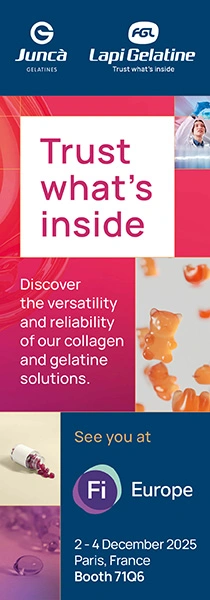DSM to Launch Innovative Omega 3 Extraction Technology, Rules Out 2016 Acquisitions
13 Jun 2016 --- DSM is ramping up its innovation in nutritional products, as it looks to maximize potential on a series of acquisitions in recent years, including a novel omega 3 DHA/EPA extraction technology. Further major acquisitions can be ruled out in 2016, but the company is of course on the lookout. This is according to André Bos, President, Human Nutrition & Health, DSM Nutritional Products, who spoke to FoodIngredientsFirst, in a week in which the company opened a vitamin B6 facility in China. The vitamin B6 facility is being hailed as an example of DSM’s investment in category growth and its continued commitment to its leadership position in the global industry.

Bos revealed that the company is set to launch a major innovation in the omega 3 space in Q3 [first in the US], which overcomes the natural fluctuations in fish oil quality and nutritional composition. It follows the investment in their Mulgrave facility in Canada [formerly part of Ocean Nutrition Canada (ONC), which was acquired in 2012] which gave the company a stronger foothold in omega 3 fish oil.
“We are now able to completely separate the EPA (eicosapentaenoic acid) and DHA (docosahexaenoic acid) streams out of the fish oil in a very efficient production process. If you see it in front of you, you can have 100% EPA and 100% DHA. Then we can mix it again in one go to have exactly the same concentration, but with very high concentration levels,” he says.
 “The customers that we have so far at our facility see this as a major differentiation possibility that they can have in their local facilities to be able to do exactly what customers want to address the specific health benefit platforms that they are targeting. You can go to higher concentrations and in turn smaller capsule sizes, which makes it therefore more friendly, with the mixture the customer wants. So we are entertaining many customers now with that concept,” he reveals.
“The customers that we have so far at our facility see this as a major differentiation possibility that they can have in their local facilities to be able to do exactly what customers want to address the specific health benefit platforms that they are targeting. You can go to higher concentrations and in turn smaller capsule sizes, which makes it therefore more friendly, with the mixture the customer wants. So we are entertaining many customers now with that concept,” he reveals.
For Bos [pictured], the move will give the company much more flexibility, also from the fish source, as it makes them more flexible in taking a sustainable fish source. “But the fluctuation in the quality of the fish is such that if you can separate completely it makes you much more independent from what kinds of issues you can get,” he notes.
Bos noted that when ONC was initially acquired in 2012, the initial thought was in capacity expansion, but this strategy was shifted. “There are a lot of players in the fish oil market. So we came to the conclusion that since we have enough capacity, it is better to go for differentiation and listening to customer needs. They wanted to be able to target the market much better and at higher concentration levels,” he notes. The product will initially target the nutrition sector, but could ultimately be launched in pharma too.
Bos also revealed upcoming innovation in the colors space, with nature identical red and blue [gardenia blue based on plant extracts] alternatives to artificial colors. “We are actively working in the coloration field, utilizing our fermentation knowledge in the vitamin space and producing those colors which are now produced artificially in a nature identical form – we are especially active in blue and red. There are still a few artificial colors out there, but regulation is pushing them out. We expect to launch very soon. We are also active in the carotenoids space and are doing a lot there.”
Another area of innovation for the company is in the high-potency vitamins known as “vitamers,” which Bos notes are more active and higher dosed, with a broadening range of clinical evidence building around the benefits. “Also there we are in the market with a folic acid with much higher dosage of metafolin [through a partnership with Merck on Metafolin folate]. But we also look to how we can step up our efforts in vitamin D3 with much more active forms of vitamin D3,” says Bos.
“This is an area where there is a lot of activity ongoing, but which looks to have been there for a long time, that there is not a lot of science or new things happening, especially in the pharma market. We expect a lot of traction there, where we see pharma, such as water solubles being used in high dose, which have clinical evidence/trials being done at the moment by many companies. That might be the next breakthrough in vitamins,” he notes.
A series of acquisitions in the last 3-4 years has led DSM to cement its position as one of the biggest nutritional players out there. It included the buys of ONC, Martek Biosciences [in microalgase derived DHA], Tortuga [a Brazilian player in animal nutrition products] and the premix business of Fortitech.
“We acquired a number of companies – some big and many small. We are very happy with those and also for the people who work there. We bought them for growth and not necessarily synergies from a personnel perspective. Because all the companies we bought were around a new technology. There were many small ones too and we could add them to our growth ambition, either because of technology, assets or market access that we didn’t have. It all contributed to what we are today,” he notes.
“We are not yet fully done with getting all the value out and getting them fully integrated in the way we would like. It is also a matter of patience. Then you look around again, especially in a growing market and the position we are in today,” says Bos.
As a result of this, Bos ruled out another major acquisition this year. “In strategy, you don’t wait for years before analyzing and wait to see what to do next. We are always ready for potential steps, should they need to be taken. If the market is ready, we need to be able to move, but we have no proactive plans to do something right now,” he notes.
Bos was speaking after DSM made a substantial investment of over US$100 million in a new vitamin B6 production facility in the Xinghuo Development Zone of the Fengxian District of Shanghai, China for the exclusive supply of vitamin B6. Featuring unique technologies for outstanding product quality and reduced environmental impact, the new plant will help customers worldwide meet the growing demand of vitamin B6. The global vitamin B6 market is growing at the rate of 2% (CAGR).
The new facility is fully aligned with DSM’s Quality for Life principles which champion quality, sustainability, reliability and traceability. The advanced clean technology installed at the new facility delivers unique advantages. For example, substantial effort is made to isolate all by-products in such a high purity that they can be re-used in a sustainable way, such as fertilizer. This approach results in less waste and it supports sustainable manufacturing goals.
Measures to improve environmental performance of the new plant include the purification and isolation of by-products for use in other industries, the application of heat integration at every viable opportunity, as well as reduced water consumption via strategic recovery and re-use.
The new production plant will secure the supply of high quality vitamin B6 for DSM’s customers worldwide across food, beverage, dietary supplements, personal care and animal nutrition sectors. Already a major international supplier of vitamin B6, DSM’s investment in this dedicated, modern facility ensures the company is well placed to meet current and future demands – particularly the rapid growth of the Chinese market.
The plant will fully replace DSM’s vitamin B6 production in Grenzach, Germany in mid-2017 [end of life-time], with a transition period currently running. DSM will continue to produce vitamins B1, B2, D3 and a series of intermediates for vitamins at Grenzach, but the vitamin B6 plant will be demolished.
“The plant in China has been ramped up and the one in Grenzach is being wound down. The stock is being used to cater to markets with the longest and most cumbersome timelines for transition from a reregistration perspective, such as Japan and India. The capacity is of course bigger than in Germany, as we want to enable the growth we expect in our sales, but also in the market to be absorbed by the new capacity,” Bos explains.
by Robin Wyers
A full interview with André Bos on DSM’s strategy and ambitions will appear in the July/August summer nutrition issue of The World of Food Ingredients [Nutrition Insight].











